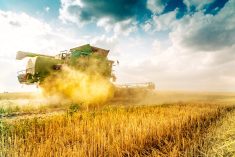Last year, 11 people were killed on farms in Alberta.
Over the past 11 years in the province, an average of just over 15 people have lost their lives each year on farms. Most were the owner/operators of the farm.
We urge you to make a commitment now, to keep yourself, your family and your employees safe. This can start with being aware of the most pressing threats on your farm at each time of the year.
Read Also

Guarding against misinformation: Do you believe in house hippos?
Misinformation and disinformation run rampant in today’s digital age. Farmers must be wary of the digital dangers and know how to keep themselves safe.
[RELATED] Be safe and profitable when storing grain
Did you know that falls were one of the most common types of incidents on Alberta farms last year? Now can be a dangerous time of year for falls because constantly changing weather conditions can make it easy to fall when walking across the yard or from a height while checking grain bins.
I want to focus on grain bins specifically, because two of the 11 fatalities last year were falls from a grain bin and both were an owner/operator on that farm.
Grain bins are much bigger than they used to be, with some reaching as high as 60 feet. However, even a fall from less than 10 feet can be fatal or cause serious injury.
The Alberta Occupational Health and Safety Code requires other industries to have a fall protection plan in place when a worker may fall three metres or more and the worker is not protected by guard rails. Although this part of the code does not directly apply to farmers and ranchers, you are still required to take measures to ensure individuals working at heights are protected as far as reasonably possible.
The other significant component to these injuries is that they often happen when the person is working alone.
[RELATED] Take it personally — and make a commitment, says farm safety expert
This means the person may have to wait a long time for help to arrive. It is important to let people know where you are working and have a check-in plan. Even better, have someone come along when possible.
Based on these two points, we are asking farmers and ranchers to take time this winter, before climbing bins or any other height on the farm, and ask the following questions:
1. Is there any corrosion or other factors that may impact the ladders attached to the bins?
2. Is the person climbing trained to climb? Is there any other factor that may impact their ability to climb (including people taking medication or substances that may make them dizzy, people with physical weakness or severe arthritis, and those experiencing illness that affects their balance or makes them dizzy)?
3. If you have employees or contractors who need to climb, have you ensured their safety as far as reasonably practicable (i.e., performed hazard assessments and put appropriate hazard-control measures in place)?
Going beyond grain bins, as the year ends and winter finds us with a little more time inside, now is a great time to make farm safety a priority for your operation and to map out a plan to make improvements for the new year.
If you don’t know where to begin, reach out to us for assistance.
I wish you all a safe and happy winter season.
Jody Wacowich is the executive director of AgSafe Alberta. The organization’s November newsletter has an article detailing the hazards posed by grain bin ladders. The article also has a list of eight steps that can be taken to reduce the risk. It can be found at agsafeab.ca (click on the Newsletter tab).















